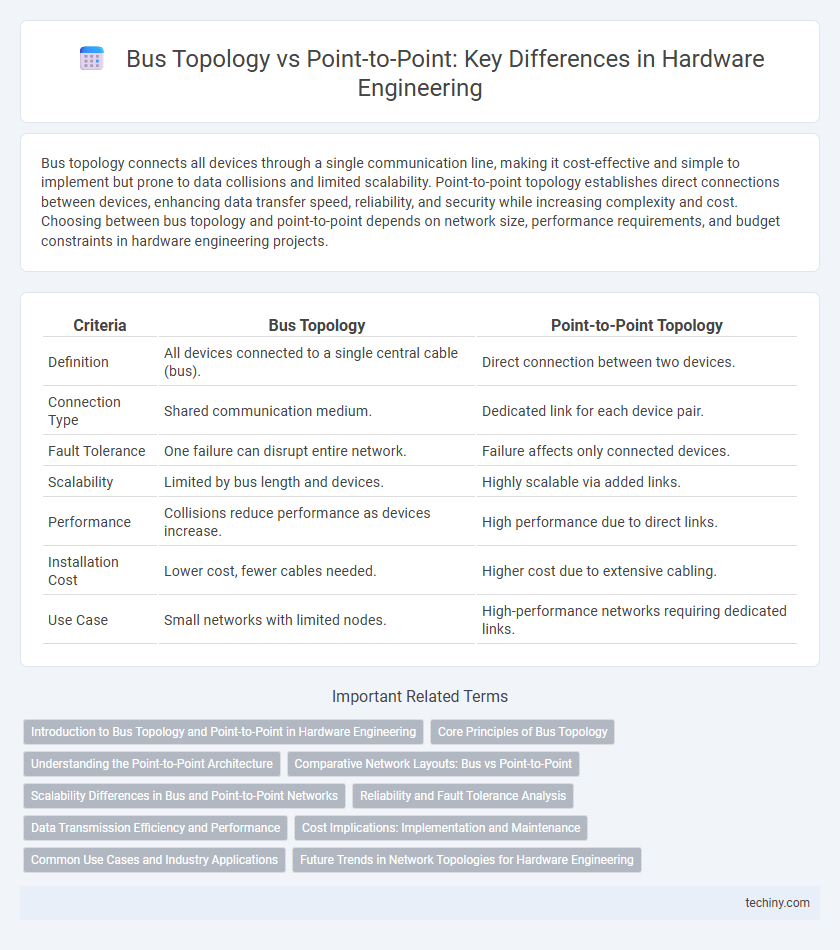Bus topology connects all devices through a single communication line, making it cost-effective and simple to implement but prone to data collisions and limited scalability. Point-to-point topology establishes direct connections between devices, enhancing data transfer speed, reliability, and security while increasing complexity and cost. Choosing between bus topology and point-to-point depends on network size, performance requirements, and budget constraints in hardware engineering projects.
Table of Comparison
| Criteria | Bus Topology | Point-to-Point Topology |
|---|---|---|
| Definition | All devices connected to a single central cable (bus). | Direct connection between two devices. |
| Connection Type | Shared communication medium. | Dedicated link for each device pair. |
| Fault Tolerance | One failure can disrupt entire network. | Failure affects only connected devices. |
| Scalability | Limited by bus length and devices. | Highly scalable via added links. |
| Performance | Collisions reduce performance as devices increase. | High performance due to direct links. |
| Installation Cost | Lower cost, fewer cables needed. | Higher cost due to extensive cabling. |
| Use Case | Small networks with limited nodes. | High-performance networks requiring dedicated links. |
Introduction to Bus Topology and Point-to-Point in Hardware Engineering
Bus topology connects multiple hardware devices using a single communication line shared among all nodes, enabling data transfer through a common bus. Point-to-point topology establishes a direct link between two devices, providing dedicated communication channels that reduce interference and enhance signal integrity. These fundamental network architectures impact hardware performance, scalability, and fault tolerance in electronic systems and embedded designs.
Core Principles of Bus Topology
Bus topology operates on a single communication line shared by all connected devices, where data signals travel in both directions and only one device transmits at a time to avoid collisions. This architecture relies on terminators at each end of the bus to prevent signal reflection and maintain data integrity. Its core principle emphasizes simplicity and cost-efficiency for small networks, though performance degrades as more devices share the same bus due to increased data traffic.
Understanding the Point-to-Point Architecture
Point-to-point architecture in hardware engineering establishes a dedicated communication link between two devices, ensuring high-speed data transfer and reduced latency compared to bus topology. Unlike bus topology, which shares a single communication channel among multiple devices, point-to-point connections eliminate collisions and signal degradation by providing exclusive pathways. This architecture enhances system reliability and scalability, making it ideal for high-performance computing and networking applications.
Comparative Network Layouts: Bus vs Point-to-Point
Bus topology connects all devices through a single communication line, making it cost-effective but prone to data collisions and limited scalability. Point-to-point topology establishes direct links between pairs of devices, offering higher reliability, faster data transfer rates, and easier fault isolation. Network performance and complexity significantly differ, with bus favored for smaller or simpler setups and point-to-point ideal for high-speed, critical hardware systems.
Scalability Differences in Bus and Point-to-Point Networks
Bus topology exhibits limited scalability as adding more devices increases signal degradation and collision chances, reducing network performance. Point-to-point networks scale more efficiently by establishing direct connections between devices, minimizing interference and maintaining high data transfer rates. The scalability advantage of point-to-point architecture supports complex hardware systems requiring robust, high-speed communication.
Reliability and Fault Tolerance Analysis
Bus topology exhibits lower reliability due to a shared communication line where a single fault can disrupt the entire network, making fault isolation challenging. Point-to-point topology enhances fault tolerance by providing dedicated connections between devices, allowing isolation and minimizing the impact of individual link failures. Hardware engineers favor point-to-point architectures for mission-critical applications requiring high uptime and robust fault management.
Data Transmission Efficiency and Performance
Bus topology often experiences data collisions and signal degradation as multiple devices share a single communication line, leading to lower transmission efficiency and reduced overall performance. Point-to-point connections provide dedicated channels between devices, minimizing interference and maximizing data transfer speed and reliability. This direct communication setup enhances bandwidth utilization and ensures higher performance in hardware engineering applications requiring rapid and consistent data exchange.
Cost Implications: Implementation and Maintenance
Bus topology offers a cost-effective solution due to its minimal cabling requirements and simpler implementation compared to point-to-point topology, which demands extensive cabling and dedicated connections for each device. Maintenance expenses in bus topology tend to be higher over time because a single cable failure can disrupt the entire network, requiring more frequent troubleshooting and repairs. Point-to-point topology, while initially more expensive to implement, often results in lower maintenance costs due to its isolated connections that simplify fault detection and limit network downtime.
Common Use Cases and Industry Applications
Bus topology is commonly used in small-scale networks and legacy systems where simplicity and cost-effectiveness are prioritized, such as early Ethernet implementations and industrial automation networks. Point-to-point topology is preferred in high-performance environments like data centers and telecommunications, offering direct, dedicated connections for faster and more reliable data transfer. Industries such as aerospace and automotive leverage point-to-point connections for critical real-time communication and high-speed signaling between sensors and control units.
Future Trends in Network Topologies for Hardware Engineering
Bus topology faces limitations in scalability and fault tolerance compared to point-to-point configurations, which offer enhanced performance and reliability through dedicated connections. Emerging trends in hardware engineering emphasize hybrid topologies that integrate point-to-point links with mesh networking to support high-speed data transfer and low latency in complex systems. Advances in optical interconnects and quantum communication are also driving the evolution of network topologies, enabling faster and more efficient hardware designs.
Bus topology vs Point-to-point Infographic

 techiny.com
techiny.com